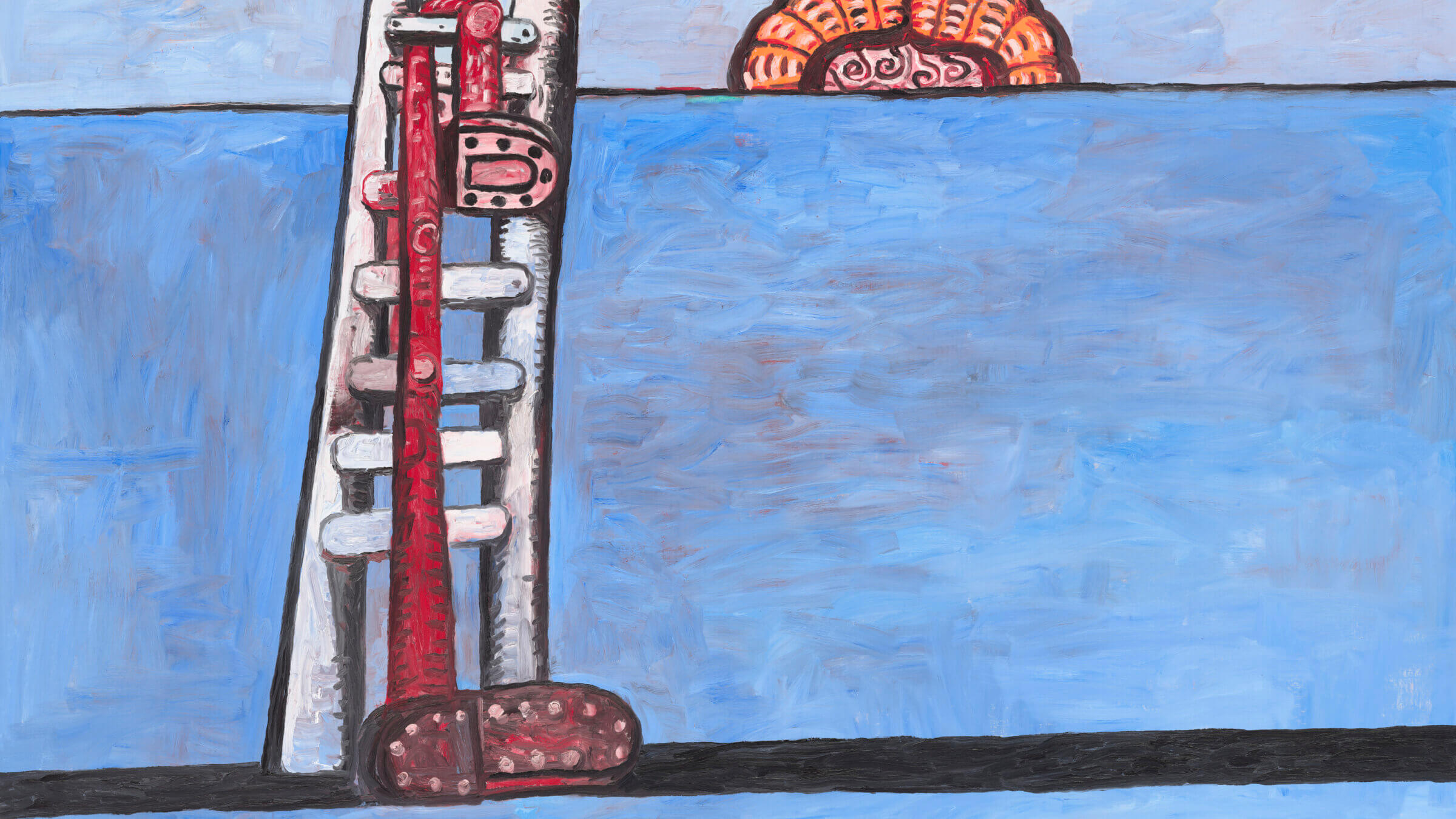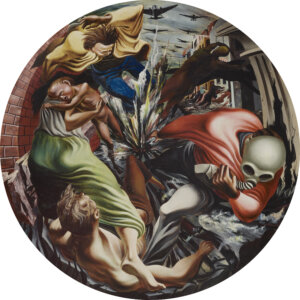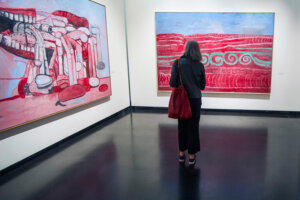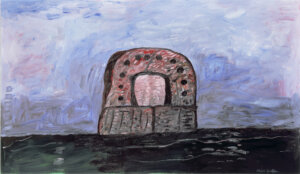How a Jewish ‘witness of hell’ navigated a landscape of American terror
Born Philip Goldstein, painter Philip Guston was haunted by the tragedies of the past and the horrors of the present

Philip Guston’s ‘The Ladder,’ 1978. Photo by National Gallery of Art, Washington, Gift of Edward R. Broida © The Estate of Philip Guston
Philip Guston Now, the monumental retrospective currently on view at Washington’s National Gallery of Art, showcases just how daring the work of the Canadian-American artist born Philip Goldstein remains.
Guston died in 1980 at the age of 67. Visiting the exhibit this month at the National Gallery of Art in Washington, D.C., I was bowled over by both the contemporary and the historical relevance of his work. His bracing sensibility is yoked to the dual timelines of European antisemitism and American prejudice that he and his immigrant parents lived through in the last century. In our century, the startling hooded figures in white that pervade so many of Guston’s canvases still pack tremendous power. In fact, curators were so worried that viewers might misinterpret the artist’s anti-racist message that the exhibit’s four-museum tour was delayed two years. (The show has already appeared in Boston and Houston; after it leaves Washington on Aug. 27, its final stop will be the Tate Modern, London.)
Guston’s work evolved over the decades from realistic painting featuring unsettling backdrops and enigmatic imagery, to colorful abstract canvases both lyrical and sobering, and finally to his own absurdist mix of at first loony-looking (but on closer inspection bitterly satirical) cartoon-like figures at large in a sinister world gone askew.
What to make of it all? According to Guston’s close friend Philip Roth, these works portray nothing less than “a new landscape of American terror.” As the title of the exhibit Philip Guston Now suggests, we continue to inhabit — and perhaps never left — a patch of that same landscape.
Focused on the present and the past

One way to map out and enter that landscape is via the personal tragedies that marked Guston’s life and the catastrophes of war and prejudice that marred his times. That path begins and frequently coincides with his Jewish heritage.
When Guston’s parents Leib and Rachel Goldstein left Ukraine in the first decade of the 20th century with their three oldest children to settle in Montreal, they hoped they had left the poverty and pogroms of the Old Country behind. But after having three more children — Philip, the youngest, was born in 1913 — and still no financial success, they sought yet another fresh start, moving to Los Angeles in 1922. There, the family was exposed to the Ku Klux Klan’s vicious actions against Jews and Blacks, rampant throughout the state at that time.
The family also continued to struggle financially, with Leib only able to find employment as a junkman. Increasingly despondent, in 1923 he used a rope to hang himself from a rafter in the back of the house. Guston, 10 at the time, recalled finding him and cutting him down. Another grim trauma occurred in 1932 when Guston’s favorite older brother Nat died from gangrene after his car rolled backwards, crushing his legs.
By this time Guston, still in his teens, had discovered his love for drawing and had started publishing cartoons in his local and school newspapers. He also pursued leftist politics. In 1932 and early 1933, he joined with like-minded friends to paint murals for an exhibition at the local communist John Reed Club protesting the false accusations, convictions and death sentences of the Black youths from Alabama known as the Scottsboro Boys. Before the show could open, though, the so-called Red Squad of the Los Angeles Police Department, known for cracking down on communists and unions, raided the club and vandalized the murals.
Motifs and memories from all these events — images of ropes, lifeless hanging bodies, crushed legs, hooded figures in KKK robes and the imagined carnage from pogrom-like violence — haunted Guston’s work for the rest of his career. He also took cues and influences from the great artists of the past. One of the most striking examples is his use as a model for two of his own early works of 15th-century painter Piero della Francesca’s fresco The Torture of the Jew.
The fresco depicts two young men adjusting the ropes and pulleys of a wooden gallows, beneath which crouches a man (apparently the Jew) whose dark curly hair is decisively gripped by a well-dressed official in charge of the punishment. Guston’s 1930 Drawing for Conspirators portrays a hooded Klansman in the foreground who wraps a thick rope around his hands like a rosary, while behind him a group of Klansmen oversee the hanging of a dark-skinned figure, even as a large crucifix is hoisted at a severely tilted angle nearby. Guston’s composition, framed by the crenellated walls of Renaissance architecture, depicts nothing less than a ritualized form of torture, sanctioned with unholy hypocrisy by the religious and governmental powers that be.
A change of name but not a change of heart

In the mid-1930s, he started calling himself Guston, rather than “Goldstein,” fearing that the parents of his bride-to-be, the poet and artist Musa McKim (his 1942 Edward Hopper-like portrait of her is stunning), might reject her Jewish suitor. It was a decision he later regretted, he said, but it was one in keeping with the American mood of assimilation. The two married and moved to New York. There, he created his powerful response to the atrocities of the Spanish civil war and the spread of Fascism in Europe, the dynamically circular shaped painting Bombardment. The painting seems to explode with swirling bodies propelled into the air by the fiery impact of mass aerial bombing. It’s more apocalyptic than the destruction of Sodom and Gomorrah.
His work from the early 1940s continued along this trajectory, combining surrealism and social protest. In the wake of World War II, news of the horrors of the Nazi death camps and the Holocaust affected him deeply. He based his paintings The Porch and The Porch II on photos of shattered camp survivors, their thin bodies alternately upright and upside down, some with faces turned away, others with eyes masked, or hands covering their mouths as if caught between howling in grief and shocked into silence.
In the years that followed, Guston’s work became increasingly abstract as he aligned himself with the New York school of abstract expressionists. He brandished loose brush strokes to fill canvases with splotches of color, both airy and deeply intense. These works garnered critical acclaim. But by the end of the 1960s he had begun to turn away from abstraction.
Among the first results of his return to representation was a series of canvases out of whose thick gray and black shadows of paint emerge block-like but discernible images of the Golem of Jewish folklore, a creature made out of earth and clay capable of being animated by a kabbalistic formula. The golem myth may have allowed Guston himself to understand his paintings as creations that he had brought to life, writes Tate Modern curator Mark Godfrey in the catalogue accompanying the exhibit. That idea resonates with the powerful canvas, The Line, in which a giant hand reaches down from the skies above to draw a line across the red surface below; this was Guston the Golem, the painter, creating his own lines across the surface of the earth.
His break with abstract expressionism and reinvention of himself as a figurative painter with a raw, cartoon-like style created an uproar in the art world, with many old friends turning against him as a result. But it was 1968, a moment riven by police beatings of peaceful civil rights demonstrators, increasing outcries against the brutal war in Vietnam, and the assassinations of Martin Luther King, Jr., and Robert Kennedy. The times required him to change direction and, he said, “tell stories” through his art. More specifically, these stories centered on themes of injustice, prejudice and repression, outcries against antisemitism, racism, and the horrors of wars past and present.
Witness of hell

Guston’s love of cartoons had never left him. “Like most kids of his generation, Guston adored the newspaper funny pages and he never lost the taste,” with Bud Fisher’s Mutt and Jeff as a favorite, explains graphic artist Art Spiegelman, author of Maus, in an essay in the exhibit catalogue. Perhaps that is why, Spiegelman suggests, “The simple immediacy of cartoon signs satisfied his need to tell stories again.”
Among these late canvases are also his own versions of the Biblical stories of the Red Sea and the Exodus. In one of his most striking paintings, he portrayed an unfurling Torah scroll against a black and gray backdrop tinged with red and white. After suffering a severe stroke in 1978, he asked that his friends (including Philip Roth) recite the kaddish for him at his funeral.
“Our whole lives (since I can remember) are made up of the most extreme cruelties of holocausts. We are the witnesses of the hell,” he wrote his friend, the poet Bill Berkson. In viewing Guston’s work, we are also bearing witness. His searing works of pain and prophecy compel us to cry out and try to heal our broken world.















